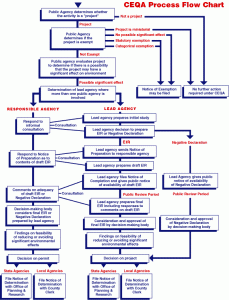Will Enviros Bend on CEQA Reform?
CEQA, the California Environmental Quality Act, has long been the third rail of politics here in theGoldenState. If a politician dare touch it, he or she is dead to the state’s powerful environmental lobby.
Gov. Jerry Brown this week placed environmentalists in a quandary. He released a package of CEQA reforms that would expedite the approval process for both “infill” housing projects and solar energy projects (provided they are to be built on existing rooftops or parking lots).
On one hand, enviros hate the idea of relaxing CEQA, which they use as a weapon to obstruct, if not kill altogether, construction projects they oppose.
On the other, they are big proponents of infill — rather than green field — housing development. And they are strong advocates of renewable energy, like solar, as a replacement for dirty old fossil fuels.
The governor is urging the environmental lobby to get with his program; which, he said, will not only be good for the environment, but also will create some of those half-million green jobs he promised during his campaign for the state’s highest office.
“Like California,” he said, “CEQA must be more nimble.”
As it is now, the 42-year-old law is anything but nimble. Its original goal was reasonable enough: To notify the public about the potential environmental impact of proposed development projects and to mitigate those potential environmental impacts to the extent “feasible.”
But the CEQA process has proven complex and unpredictable, as the state Legislative Analyst’s Office has attested.
It all but invites legal challenges to development projects, including, increasingly, lawsuits that have little to do with the environment. And its compliance costs make building anything in California — including infill housing and solar projects — more expensive than anywhere else in the country.
‘Unreasonable Results’
Indeed, the California Chamber of Commerce issued a report last year that offered several examples of “how CEQA’s good intentions can lead to unreasonable results.”
In one case, a company that proposed to build a solar power plant was required to pay a whopping $25 million in environmental mitigation to relocate 25 endangered tortoises from the future plant site — $1 million a tortoise.
The company was forced to acquire and clean up some 12,000 acres of land for the tortoises to move to and set up an endowment to protect the new habitat from now to eternity.
In another case, a neighborhood group in Berkeley filed a lawsuit against a proposed infill housing project that was to accommodate low income families.
The suit claimed that the project ran afoul of CEQA because shadows — that’s right, shadows — the housing would cast upon the neighborhood would produce a significant environmental impact.
It remains to be seen if Gov. Brown can persuade environmental interest groups and other putative stakeholders to acquiesce to his proposed CEQA reforms. If so, it will be welcome news for solar companies (at least those installing panels on existing rooftops and parking garages) and for inner city developers of low-income housing.
It also could be the political breakthrough that eventually leads to the full-blown CEQA reform the state’s business community has long sought, but that the state’s environmental lobby has long thwarted.
— Joseph Perkins
Related Articles
What Hath Arnold Wrought?
AUGUST 26, 2010 We’re at that time in a governor’s term when we start hearing the word “legacy” on a
An open letter to bullet-train board Chairman Dan Richard
Dan Richard was at it again in Saturday’s Los Angeles Times. LAT’s Ralph Vartabedian did a good job painting a downbeat
Wide interest in redistricting
This just in: 30,275 people applied to serve on the Citizen’s Redistricting Commission. That’s right — the one with 14




